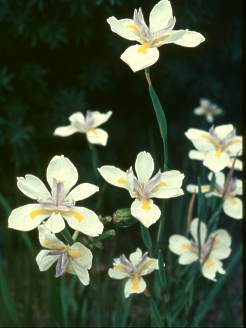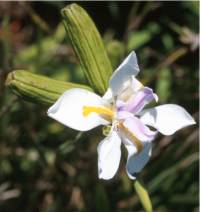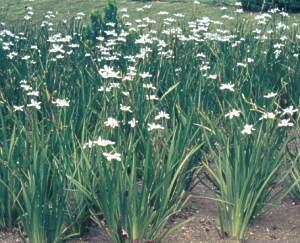Dietes grandiflora
Dietes grandiflora DC
Family: Iridaceae
Common names: large wild iris, fairy iris (Eng.); groot wilde-iris (Afr); isiqungasehlati (Z)
Introduction
This well known indigenous iris is commonly grown in gardens and used in large landscapes throughout the country.

Description
Description
Dietes grandiflora is a perennial, evergreen plant which grows up to 1.5 m, forming large clumps. The plant grows from underground rhizomes.
The long, rigid, sword-shaped leaves, held in a fan shape, are dark green and may reach up to 1 m long and 15-20 mm wide.
The attractive flowers, held on erect slender stems about 1 m in length, are large (about 100 mm across) and are white with yellow nectar guides on the outer tepals and violet central segments.

The flowers are borne in masses at certain periods — often after rain in summer. The individual flowers do not last more than a couple of days (so are of no use in a vase) however, the plant bears so many flowers during the peak period that the plant looks most striking.
This plant is occasionally called the "Fairy Iris" because the fragile white petals not only look like fairy wings, but also have a tendency to disappear mysteriously overnight!
The large wild iris fruit is a large capsule up to 45 mm which is held erect and splits open to release shiny, dark brown seeds.
Conservation Status
Status
Least Concern (LC), Dietes grandiflora is not threatened.
Distribution and habitat
Distribution description
It grows naturally along the southern and eastern coastal areas of the Eastern Cape and southern Kwazulu-Natal where it may be found in full sun or partial shade at forest margins, or in the shelter of taller shrubs on exposed slopes facing the sea.
Derivation of name and historical aspects
History
The name Dietes means 'having two relatives' and refers to the relationship between this genus and Moraea and Iris. Grandiflora means 'large flower'.
There are 6species of Dietes — five of which occur in South Africa — and one on an island in the Tasman Sea (between New Zealand and Australia). Dietes were once called Moraea (a closely related group), but were separated because Dietes have a rhizome, whereas Moraea have a true corm.

Ecology
Ecology
The flowers attract lots of bees and other pollinators.
Uses
Use
It has become a popular landscaping plant due to its reliability and hardiness and is often found in parking areas at shopping centres, schools etc. It can be effectively used in mass plantings, but is also effective in mixed plantings or used as an accent plant alongside a pond or some steps.
Growing Dietes grandiflora
Grow
This is a popular, easy-to-grow garden plant which will grow under most conditions. The plants are both frost and drought hardy and will grow in either sun or shade. However, for best results and most flowers, plant Dietes grandiflora in full sun or light shade in well composted, well drained soil and water well in summer.
The large wild iris is easy to propagate from seed sown in spring or by dividing large clumps which spread by means of rhizomes. They multiply rapidly and are soon ready to be split again.
References
- Batten, A. 1986. Flowers of Southern Africa. Frandsen Publishers : Sandton
- Eliovson, S. 1984. 7th ed. Wild Flowers of Southern Africa.
- Joffe, P. 2001. Creative Gardening with Indigenous Plants - A South African Guide. Briza Publications : Pretoria
- Pienaar, K. 1985. Grow South African Plants Struik Publishers : Cape Town
- Pooley, E. 1998. A Field Guide to the Wild Flowers of KwaZulu-Natal and the Eastern Region. Natal Flora Publications Trust : Durban
- Van der Spuy, U. 1971. Wild Flowers of South Africa for the Garden. Hugh Keartland Publishers : Johannesburg
- Walker, J. 1996. Wild Flowers of KwaZulu Natal. W.R.Walker Family Trust : Durban
Credits
Sharon Turner
Walter Sisulu National Botanical Garden
December 2001
Plant Attributes:
Plant Type: Bulb
SA Distribution: Eastern Cape, KwaZulu-Natal
Soil type: Sandy, Loam
Flowering season: Spring, Early Summer, Late Summer
PH: Acid, Alkaline, Neutral
Flower colour: White, Yellow
Aspect: Full Sun, Morning Sun (Semi Shade), Afternoon Sun (Semi Shade)
Gardening skill: Easy
Special Features:
Horticultural zones











Rate this article
Article well written and informative
Rate this plant
Is this an interesting plant?
Login to add your Comment
Back to topNot registered yet? Click here to register.